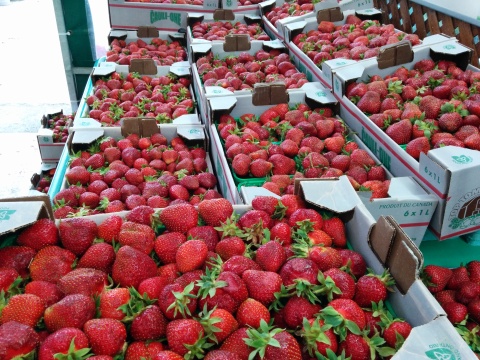
Strawberries are tricky. Definitely one of the yummiest summer fruits around, and perhaps the nicest jam of all (except for all the others). But they are so low in pectin, the magic ingredient that makes jam set, that it’s always a gamble whether you’re going to end up with jam or syrup. Or a sweet, tasty liquid with strawberry lumps.
Last year canning buddy and I had a bold day of experimenting with various pectin options, which included the much-vaunted Pomona pectin (which is surprisingly hard to find in Canada) as well as using raspberries, gooseberries and home-made gooseberry pectin to ensure a set. I didn’t like the Pomona pectin jam at all. Low suger, it’s true, and a good, if firm set. But I didn’t like the taste. This year was a little less experimental, but mostly successful, with a fast and simple race through strawberry jam, four ways. The method and the fruit-jam-lemon ratio was the same for all of them, but there were tweaks to the pectin and the flavourings.
Fruit-jam ratio: Seven cups of chopped up fruit (our traditional ratio would call for 6, but we added an extra cup this year.); 4 not quite full cups sugar; juice of two lemons.
Basic method: Mix fruit, lemon juice and sugar and allow it to sit around for as much time as you have. Heat gently until the sugar dissolves, and then at a rolling boil for at least 10 minutes. It will foam madly at the start — use a big, big pot. But the foam dies down as the boil goes on. Add whatever you are using for pectin and boil for another 5 minutes or so until it seems to set. Add any extra flavourings and boil a little longer. Bottle in sterilized jars. Waterbath for 10 minutes.
Strawberry, kiwi, mint (5 jars)
This is based on a New York Times recipe, which uses one and a half finely chopped kiwis for the pectin that the strawberries lack (and adds that kiwi right at the start, as opposed to the later-on addition in the basic recipe). Finely chopped mint goes in at the end. It’s very good, although the little black specks of kiwi can be marginally disconcerting.
Strawberry lemon (5 jars)
Add the zest of three lemons before you start cooking the jam. It’s an interesting flavour, although I’m not sure yet whether I really like it. We used a cube of last year’s frozen gooseberry pectin toward the end of the boil and yes, it set. We could have used kiwi instead, or crabapple pectin. (Must make more of that this year.)
Strawberry balsamic pepper (5 jars)
Also with a cube of frozen gooseberry pectin for set (use a kiwi as an alternative). Add 3 tbsp of balsamic vinegar and about 1/2 tsp of freshly ground black pepper about five minutes before the end. Very yummy, with a lovely pepper kick that reminds me of the hugely successful peach white pepper jam we’ve made several times.
Strawberry rhubarb (6 jars)
With gooseberry pectin again (or kiwi). It’s a lovely taste combination because you get the sweetness of the strawberry and the tartness of the rhubarb. We used 4 cups strawberries and three of rhubarb. I think.














 I still had some fruit left over, so I switched to a quick batch of
I still had some fruit left over, so I switched to a quick batch of 

 We mostly worked with a proportion of 7 cups of fruit, four cups of sugar and the juice of two lemons, which cut the sugar somewhat from our normal 6-4-2 ratio. It seemed to work, although the jams are mostly a little on the runny side. Not a problem my end, given that most of my jams end up in yogurt rather than on bread:
We mostly worked with a proportion of 7 cups of fruit, four cups of sugar and the juice of two lemons, which cut the sugar somewhat from our normal 6-4-2 ratio. It seemed to work, although the jams are mostly a little on the runny side. Not a problem my end, given that most of my jams end up in yogurt rather than on bread:






